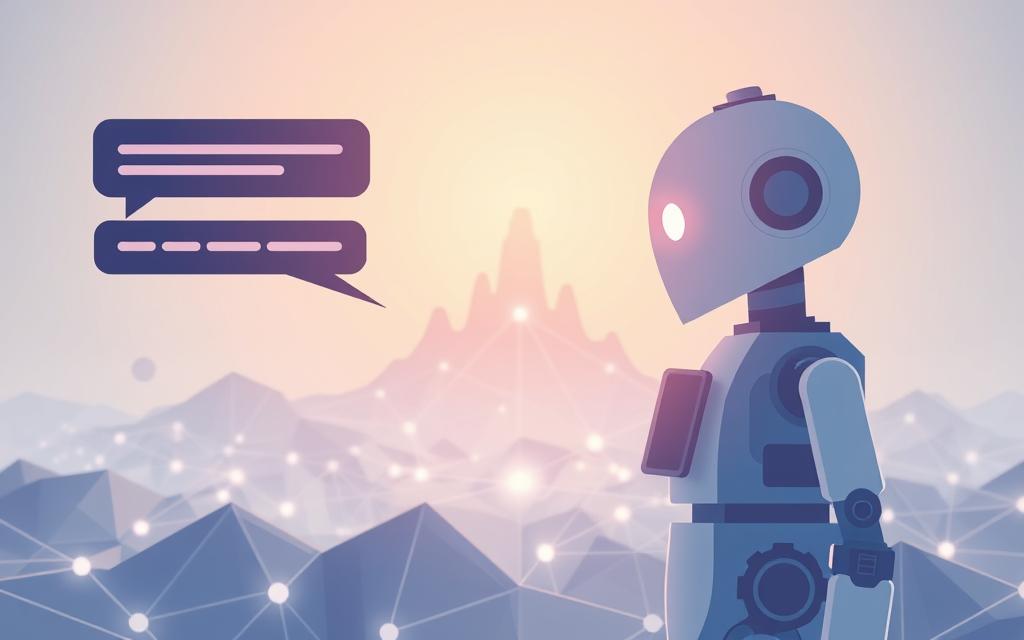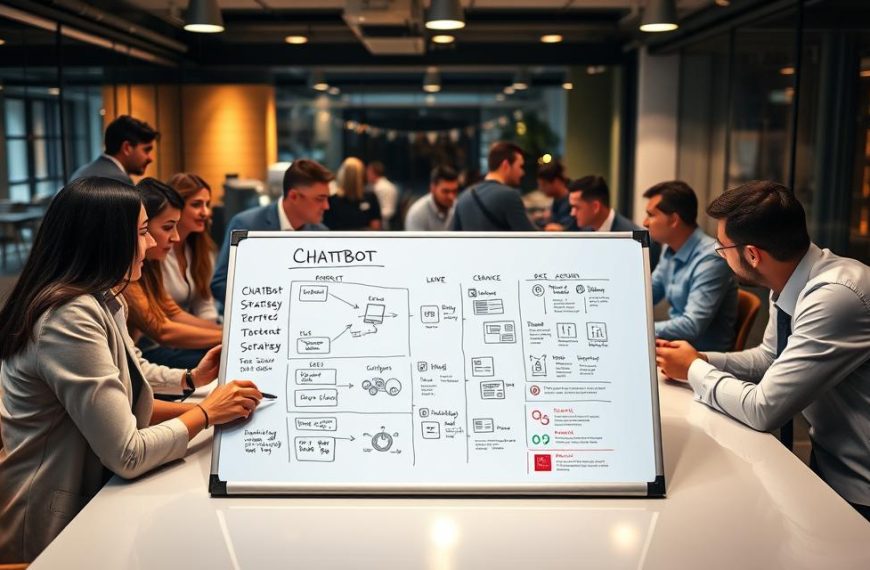Modern chatbot technology has revolutionized how businesses interact with their customers. Powered by artificial intelligence, these tools have evolved from simple FAQ programs to advanced virtual assistants capable of handling complex tasks. Today, they play a crucial role in enhancing customer experiences across industries.
One of the standout features of chatbots is their 24/7 availability. Studies show that they reduce response times by 80%, ensuring customers receive immediate assistance. Additionally, they handle up to 64% of routine inquiries without human intervention, freeing up agents to focus on more complex issues.
Enterprise applications, such as IBM watsonx integrated with Microsoft Teams, highlight the versatility of this technology. From managing password changes to scheduling healthcare appointments, chatbots streamline workflows efficiently. Their cost-effectiveness and ability to provide personalized recommendations make them indispensable in today’s fast-paced world.
With 85% of executives predicting generative AI will directly interact with customers within two years, the future of chatbot technology looks promising. Explore more about their transformative impact here.
Introduction to Chatbots
The rise of chatbots has transformed how we interact with technology. These software programs simulate human conversation using advanced techniques like natural language processing and machine learning. They’ve evolved from basic scripts to intelligent systems capable of understanding and responding to complex queries.
Defining Chatbots
Chatbots are designed to mimic human conversation through text or voice interactions. Early versions, like MIT’s Eliza in 1966, relied on keyword recognition. Today, they leverage language processing to interpret context and provide accurate responses. This shift has made them indispensable in customer service, healthcare, and more.
The Evolution of Chatbot Technology
From simple rule-based chatbots to generative AI models, the technology has seen remarkable progress. Rule-based systems follow predefined scripts, like answering “What’s the weather forecast?” In contrast, modern AI chatbots, such as ChatGPT, process billions of parameters to deliver contextual responses.
Machine learning enables these systems to improve continuously. For example, Zendesk AI agents now resolve 73% of complex banking inquiries autonomously. This evolution has led to widespread adoption, with 92% of Fortune 500 companies using chatbots for customer service.
How Chatbots Work
Behind every seamless conversation with a chatbot lies advanced technology. These tools combine natural language processing (NLP) and machine learning to understand and respond to user queries effectively. By leveraging sophisticated algorithms, chatbots simulate human-like interactions with remarkable accuracy.
Natural Language Processing (NLP) in Chatbots
NLP is the backbone of chatbot functionality. It enables systems to interpret user intent, extract key entities, and analyze sentiment. For instance, NLP chatbots achieve an impressive 89% accuracy in intent recognition, as demonstrated by Zendesk benchmarks.
The training process involves analyzing over 10,000 annotated conversation samples. This ensures the system can handle diverse queries. Sentiment analysis further enhances interactions by tailoring responses to the user’s emotional state.
Machine Learning and AI in Chatbots
Machine learning optimizes chatbot performance through continuous feedback loops. Algorithms refine responses based on user interactions, improving accuracy over time. IBM watsonx Orchestrate, for example, reduces workflow setup time by 40% using deep learning techniques.
Supervised and unsupervised learning methods play distinct roles. Supervised learning relies on labeled data for precise responses, while unsupervised learning identifies patterns in unstructured data. This dual approach ensures chatbots adapt to various scenarios.
| Learning Method | Application | Impact |
|---|---|---|
| Supervised Learning | Customer Service | High accuracy in handling predefined queries |
| Unsupervised Learning | Healthcare | Reduces misrouting by 62% |
These advancements highlight the transformative potential of chatbots. By integrating natural language and machine learning, they deliver efficient, personalized interactions across industries.
Everyday Uses of Chatbots
From customer service to healthcare, chatbots are reshaping industries. These tools handle routine tasks, improve efficiency, and enhance customer interactions. Their versatility makes them invaluable in today’s fast-paced world.
Customer Service and Support
Chatbots excel in resolving customer service inquiries. They handle password resets, order tracking, and FAQs 24/7. For example, Bank of America’s Erica processes over 50 million requests annually, ensuring quick resolutions.
Omnichannel support across WhatsApp, SMS, and social media platforms further enhances accessibility. This ensures customers receive consistent assistance, regardless of the platform they use.
E-commerce and Sales Assistance
In e-commerce, chatbots drive sales through personalized recommendations. Sephora’s chatbot increases booking rates by 11% by suggesting products tailored to user preferences. This boosts conversion rates by 35%, making it a powerful sales tool.
Chatbots also simplify order tracking and returns, improving the overall shopping experience. Their ability to handle multiple queries simultaneously ensures seamless customer interactions.
Healthcare and Appointment Scheduling
Healthcare providers use chatbots for appointment scheduling and patient triage. Cleveland Clinic’s AI assistant reduces no-shows by 27%, optimizing clinic schedules. Symptom checkers handle 40% of initial patient inquiries, streamlining workflows.
These tools also provide reminders and follow-ups, ensuring patients stay informed. This improves patient outcomes and reduces administrative burdens on staff.
| Industry | Application | Impact |
|---|---|---|
| Customer Service | Password Resets | 24/7 query resolution |
| E-commerce | Product Recommendations | 35% conversion boost |
| Healthcare | Appointment Scheduling | 27% reduction in no-shows |
Benefits of Using Chatbots
Chatbots have become a cornerstone of modern business operations. They offer numerous advantages, from reducing operational costs to improving customer satisfaction. Let’s explore how these tools are transforming industries.
24/7 Availability and Instant Responses
One of the standout features of chatbots is their ability to provide instant responses around the clock. Studies show that 68% of users prefer chatbots for quick resolutions. This ensures customers receive assistance at any time, even during off-hours.
For example, chatbots resolve 92% of issues during non-business hours. This level of availability enhances customer trust and satisfaction. Businesses can maintain seamless operations without relying solely on human agents.
Cost Efficiency and Scalability
Chatbots significantly reduce operational costs. IBM case studies reveal a 30% reduction in customer service expenses. A single interaction costs $0.50 with a chatbot, compared to $8.00 for human-assisted support.
Scalability is another key benefit. A single chatbot can handle 10,000 concurrent inquiries, making it ideal for industries like banking. This ensures businesses can manage high volumes without compromising quality.
Enhanced Customer Experience
Personalized interactions are a hallmark of modern chatbots. They improve customer experience by tailoring responses to individual needs. Companies using chatbots report a 45% increase in Net Promoter Scores (NPS).
Agents can focus 60% more on high-value tasks, thanks to chatbots handling routine inquiries. This optimization leads to faster resolutions and happier customers.
| Benefit | Impact |
|---|---|
| 24/7 Availability | 92% issue resolution during off-hours |
| Cost Efficiency | 30% reduction in customer service costs |
| Enhanced Customer Experience | 45% higher NPS scores |
By leveraging chatbots, businesses achieve remarkable efficiency and customer satisfaction. These tools are not just a trend but a necessity in today’s competitive landscape.
Chatbot Technologies
The evolution of chatbot technologies has paved the way for smarter, more efficient interactions. From basic rule-based systems to advanced generative AI chatbots, these tools have transformed how businesses and customers connect. Today, they handle complex tasks with ease, thanks to innovations in language processing and automation.
Rule-Based Chatbots
Rule-based chatbots operate on predefined scripts and decision trees. They excel at handling straightforward queries, like answering FAQs or providing basic information. However, their capabilities are limited to the scenarios they’re programmed for.
For example, a rule-based system can respond to “What’s my account balance?” but struggles with open-ended questions. Despite their limitations, they remain a cost-effective solution for businesses with predictable workflows.
Generative AI Chatbots
Generative AI chatbots represent the next leap in technology. Powered by advanced algorithms, they generate contextual responses based on user input. These systems now handle 41% of enterprise customer interactions, offering a more natural and dynamic experience.
Unlike rule-based models, generative AI can adapt to diverse queries. For instance, IBM watsonx uses deep learning to provide accurate, real-time solutions. This flexibility makes them ideal for industries like healthcare and finance.
Virtual Agents and AI Agents
Virtual assistants and AI agents take automation to the next level. They integrate with robotic process automation (RPA) to manage multi-step workflows. For example, virtual agents resolve 83% of IT helpdesk tickets without escalation.
Platforms like Zendesk AI and Drift Conversational Sales highlight their versatility. Security measures, such as encryption protocols, ensure safe interactions in sensitive sectors like healthcare. With 78% of retailers adopting AI agents for order management, their impact is undeniable.
Chatbots in Different Industries
Industries worldwide are leveraging chatbot technology to streamline operations and enhance customer experiences. From retail to healthcare and banking, these tools are transforming how businesses interact with their audiences. Their ability to handle complex tasks while ensuring compliance with industry standards makes them indispensable.
Retail and E-commerce
In the retail sector, chatbots are driving sales and improving customer engagement. H&M’s chatbot, for instance, increases average order value by 28% through upselling. Sephora’s Color Match feature boosts conversion rates by 12% by offering personalized product recommendations.
These tools also simplify order tracking and returns, ensuring a seamless shopping experience. With 670% ROI reported by Drift users, chatbots are proving to be a valuable asset for e-commerce platforms.
Healthcare and Telemedicine
Healthcare providers are adopting chatbots to enhance patient care and streamline workflows. Babylon Health triages 40% of UK NHS inquiries, reducing the burden on medical staff. These tools also ensure compliance with HIPAA regulations, safeguarding sensitive patient data.
From appointment scheduling to symptom checking, chatbots improve efficiency and patient outcomes. Their ability to handle routine tasks allows healthcare professionals to focus on critical cases.
Banking and Financial Services
In the banking sector, chatbots are revolutionizing customer support and fraud detection. Capital One’s Eno handles 58% of fraud detection inquiries, ensuring secure transactions. Chase’s chatbot processes $8 billion in payments monthly, showcasing its scalability.
These tools also comply with PCI DSS standards, ensuring secure financial transactions. By automating routine tasks, chatbots free up agents to address complex customer needs.
| Industry | Application | Impact |
|---|---|---|
| Retail | Upselling | 28% increase in order value |
| Healthcare | Patient Triage | 40% of inquiries handled |
| Banking | Fraud Detection | 58% of inquiries resolved |
Challenges and Limitations of Chatbots
While chatbots offer numerous benefits, they also face significant challenges that need addressing. From misinterpretation of user queries to security concerns, these limitations can impact their effectiveness. Understanding these issues is crucial for businesses aiming to optimize their use of this technology.
Misinterpretation and Errors
One of the most common issues is misinterpretation of user intent. Forrester reports that 22% of chatbot failures stem from natural language understanding (NLU) errors. This can lead to incorrect responses, frustrating users and reducing trust in the system.
Hallucination rates vary across models. Generic AI models experience a 18% hallucination rate, while customer experience (CX)-trained models reduce this to just 3%. Implementing human-in-the-loop verification systems can mitigate these errors and improve accuracy.
Security and Privacy Concerns
Protecting user data is a top priority. Chatbots handling sensitive information, like financial or healthcare data, must adhere to strict encryption standards. AES-256 encryption is widely used to safeguard security concerns in industries like banking.
Compliance with regulations is also critical. 89% of enterprise chatbots meet GDPR standards, ensuring user privacy. However, continuous monitoring and updates are necessary to maintain these security measures.
Maintenance and Updates
Regular maintenance is essential to keep chatbots functioning optimally. Healthcare chatbots, for instance, require 34% more frequent updates than retail versions. Bi-weekly training cycles for medical diagnosis bots ensure they stay accurate and reliable.
Scalability also depends on consistent updates. Businesses must allocate resources for ongoing maintenance to handle evolving user needs and technological advancements.
- Hallucination rates: 18% in generic models vs 3% in CX-trained AI
- Encryption standards: AES-256 for financial data protection
- Update cycles: Bi-weekly training for medical diagnosis bots
- Mitigation strategies: Human-in-the-loop verification systems
- Compliance statistics: 89% of enterprise chatbots meet GDPR standards
Future Trends in Chatbot Technology
The future of chatbot technology is brimming with innovation and endless possibilities. As businesses and consumers demand smarter, more intuitive interactions, advancements in generative AI, IoT integration, and predictive analytics are paving the way for transformative solutions. These trends promise to enhance efficiency, personalization, and user experiences across industries.
Generative AI and Advanced NLP
Generative AI is revolutionizing chatbot capabilities by enabling systems to produce human-like responses. Gartner predicts that 40% of enterprise chatbots will incorporate emotion AI by 2026, enhancing user engagement. Advanced natural language processing (NLP) techniques are also improving context understanding, reducing errors, and delivering more accurate interactions.
For example, multimodal capabilities combining voice, text, and image processing are becoming standard. Platforms like Alexa are leading the charge, offering seamless, intuitive experiences. These advancements ensure chatbots can handle complex queries with ease.
Integration with IoT and Smart Devices
The integration of chatbots with IoT devices is transforming industries. By 2025, smart home chatbots are expected to manage 35% of IoT interactions, from controlling thermostats to monitoring security systems. In industrial settings, chatbots are optimizing supply chains and managing smart factories efficiently.
Emerging technologies like quantum computing are further reducing response latency by 70%, ensuring real-time, reliable interactions. This synergy between chatbots and IoT is driving automation to new heights.
Personalization and Predictive Analytics
Hyper-personalization is becoming a cornerstone of chatbot technology. By integrating real-time data, such as purchase history and user preferences, chatbots deliver tailored recommendations and solutions. This approach boosts customer satisfaction and loyalty.
Predictive analytics is also playing a crucial role. Chatbots can now anticipate user needs, offering proactive support and suggestions. For instance, retail chatbots analyze browsing patterns to recommend products, increasing conversion rates by 12%.
- Emotion AI adoption: 40% of enterprise chatbots by 2026
- IoT integration: 35% of smart home interactions by 2025
- Quantum computing: 70% reduction in response latency
- Hyper-personalization: Real-time data integration for tailored experiences
- Adoption forecasts: 80% of customer service automated by 2027
Best Practices for Implementing Chatbots
Implementing chatbots effectively requires strategic planning and adherence to proven methodologies. By focusing on platform selection, continuous training, and robust security measures, businesses can maximize their chatbot’s potential. These best practices ensure seamless integration and long-term success.
Choosing the Right Chatbot Platform
Selecting the ideal chatbot platform is the first step toward success. Key criteria include NLP accuracy, integration capabilities, and scalability. For instance, IBM watsonx reduces implementation time from six months to just three weeks, making it a top choice for enterprises.
- NLP accuracy: Ensures precise understanding of user queries.
- Integration capabilities: Seamlessly connects with existing systems.
- Scalability: Handles growing user demands without performance issues.
Training and Continuous Improvement
Effective training is essential for chatbot performance. Healthcare bots, for example, require over 10,000 annotated conversations to achieve optimal accuracy. Regular updates and monthly performance reviews improve accuracy by 15%, ensuring the system evolves with user needs.
- Annotated conversations: Build a robust knowledge base.
- Monthly reviews: Identify and address performance gaps.
- Hybrid models: Combine AI with human oversight for 53% higher satisfaction.
Ensuring Data Privacy and Security
Protecting user information is non-negotiable. Financial chatbots, for example, must comply with SOC 2 standards to ensure data privacy and security. Encryption protocols and regular audits safeguard sensitive data, building user trust.
- SOC 2 compliance: Meets stringent security requirements.
- Encryption protocols: Protects data during transmission and storage.
- Regular audits: Identifies vulnerabilities and ensures compliance.
Case Studies: Successful Chatbot Implementations
Businesses across industries are leveraging chatbot technology to achieve measurable success. These case studies highlight how implementation of chatbots drives efficiency, engagement, and operational excellence. From retail to healthcare and banking, the results speak for themselves.
E-commerce: Enhancing Customer Engagement
In the e-commerce sector, chatbots are transforming customer engagement. Sephora’s chatbot uses augmented reality (AR) makeup trials to drive an 11% higher conversion rate. H&M’s chatbot increases average order value by 28% through personalized product recommendations.
These tools simplify order tracking and returns, ensuring a seamless shopping experience. Drift users report a 670% return on investment (ROI) in target accounts, showcasing the financial impact of chatbot adoption.
Healthcare: Streamlining Patient Interactions
Healthcare providers are using chatbots to improve patient interactions. Cleveland Clinic reduces appointment no-shows by 27% with AI-powered reminders. Babylon Health handles 1.8 million UK NHS inquiries monthly, streamlining workflows and reducing staff workload.
These tools also provide symptom checkers and follow-up reminders, enhancing patient care. By automating routine tasks, healthcare professionals can focus on critical cases, improving overall outcomes.
Banking: Improving Customer Support
In the banking sector, chatbots are revolutionizing banking support. Bank of America’s Erica saves 7 million support hours annually by handling routine inquiries. Comparus, a financial services provider, achieves 40% faster loan approvals using a banking assistant.
These tools ensure secure transactions and compliance with industry standards. By automating processes, banks can deliver faster, more efficient customer service, enhancing trust and satisfaction.
Conclusion
Chatbot technology continues to redefine customer interactions across industries. With 24/7 availability, these tools ensure immediate support, while reducing operational costs by 30%. Companies leveraging chatbots report a 45% improvement in Net Promoter Scores, highlighting their impact on satisfaction.
Strategic adoption is on the rise, with 85% of executives prioritizing artificial intelligence integration. By 2027, 80% of routine customer service tasks are expected to be automated, reshaping how businesses operate. To stay ahead, consider hybrid models that blend AI agents with human oversight for optimal results.
Looking to the future, companies using chatbots achieve 35% higher customer retention. Start your journey today to unlock efficiency, engagement, and long-term success.
















